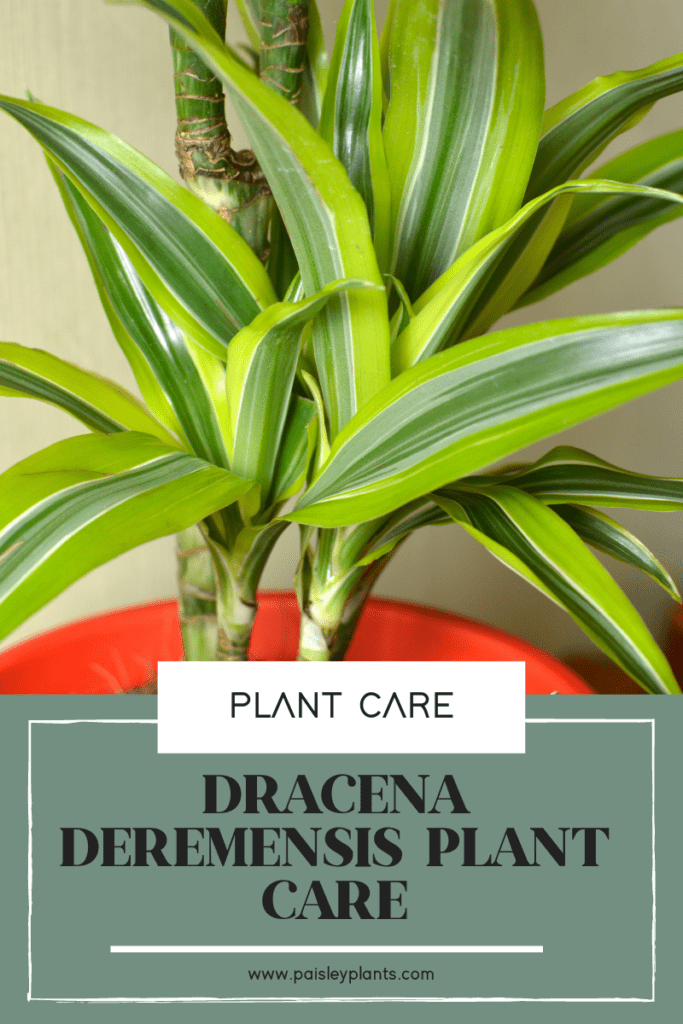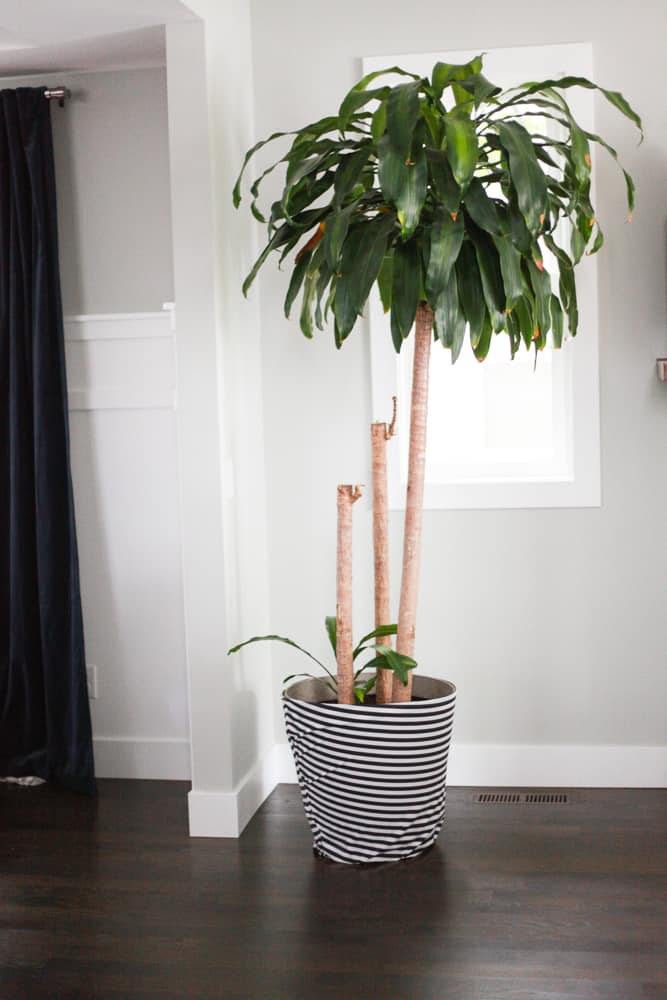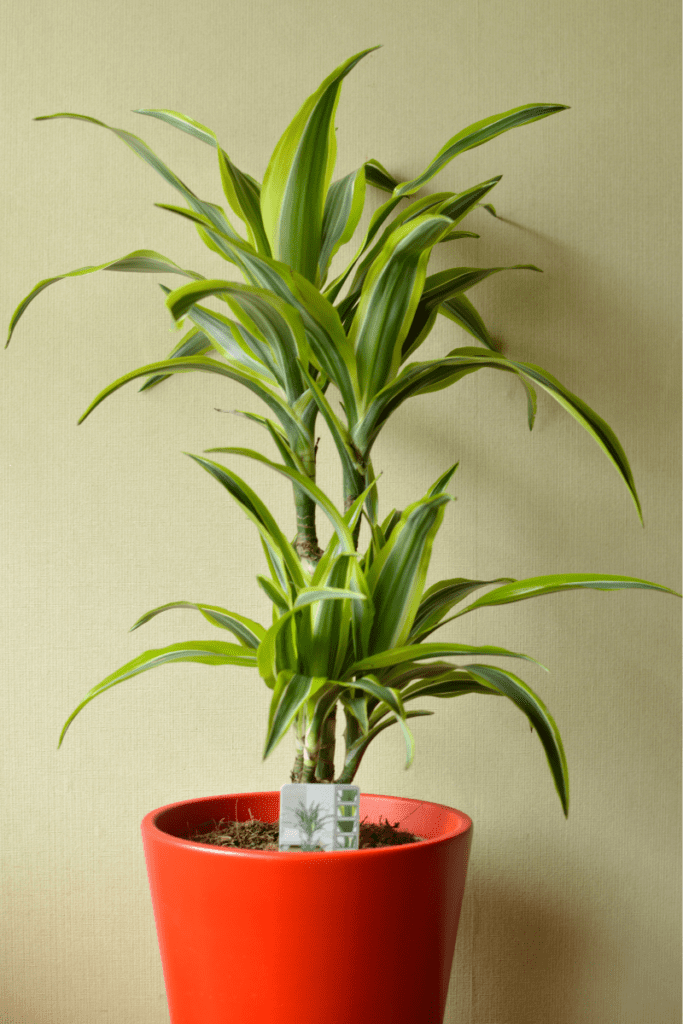Looking for a breath of fresh air for your house or office? Then you’ve come to the right place if you choose to get a Corn Plant (Dracena Deremensis) plant!
I purchased three of the Warneckii Dracena Deremensis in the spring of 2022. They are the variegated leaf type and absolutely struck me when I laid eyes on them!
At the time I bought them, each of the plants were only probably about eight inches tall. I just loved how the leaves stood pretty much straight up and also loved the colors of them.
Table of Contents
Dracena Deremensis History

This post includes affiliate links.
The Dracena Deremensis’ most common name is the Corn Plant. There are many varieties in this species which makes it confusing for many indoor gardeners.
All species and varieties of Dracena deremensis have now been merged with Dracena Fragrans which also goes by the name Janet Craig.
These plants originate in tropical regions of Africa such as Madagascar where they grow in a shrubby fashion, but can still grow to many feet tall.
Toxicity
Dracena deremensis plants are toxic to both humans and animals according to the ASPCA. The leaves contain alkyds, which if ingested, may cause vomiting and excessive salivating. Keep your plant out of reach of your small children and your pets to avoid any problems!
Air Purification
When I mentioned looking for a breath of fresh air, I wasn’t joking! This particular species of Dracena is one of NASA’s recommended air- purifying houseplants!
During their 1989 “Clean Air Study,” it was determined that these plants can absorb the five most common airborne toxins including benzene, formaldehyde, ammonia, xylene, and trichloroethylene.
This is a great reason to have several of these plants in both your home and office!
Care Tips

Watering
The Dracena deremensis is not particularly drought tolerant so needs to be watered on a regular basis. Water when the soil gets dry on the top and allow it to drain thoroughly.
Be sure to not overwater as this can lead to brown leaf tips and possible root rot. These plants do not like to sit in soggy soil so be sure your pot has drainage holes!
Light
This plant will need moderate to bright indirect light, but avoid direct light. It is an ideal plant for office interiors where there are fluorescent lights! I keep mine in a large west window where they get bright indirect light most of the day and some nice late afternoon sunshine. My plants have thrived in these conditions!
I also put all three of my plants outdoors all last summer on my deck. Boy, did they ever grow! They each grew so much that they are all at least over a foot tall now. That rain and sunshine really did a number on them and helped them grow like weeds!
If they’re grown in low light or shade their growth will be much slower. If you don’t have great light you can always use a grow light!
Soil
Use a soil that is rich in organic material and free draining to prevent it from getting soggy. This will help prevent the roots from rotting. A regular well-drained soil should be fine to use for your Dracena plants.
Fertilizer
Providing you water properly and give your plant sufficient light, you don’t need to fertilize it more than once a month – and this is only during the growing season (spring/summer months). Too much fertilizer can be harmful to your plant.
It’s a good idea to use a balanced, water-soluble fertilizer to encourage lush growth. You don’t want to fertilize during the cold season as this can lead to fertilizer burn and plant growth is minimal during this time anyway.

Temperature and Humidity
Temperatures that range between 65 degrees and 75 degrees F are ideal for this plant. They can survive for short periods of time in temps down to 50 degrees, but not below. Cold temperatures can do a lot of harm to these plants but an average room temperature is just fine!
These are hardy houseplants and do well in normal house humidity, but do like an occasional misting.
Pests and Diseases
Common pests are mealy bugs, scale insects, and spider mites. If you find any of these on your plants, you need to isolate your plant away from others so they don’t infest your other houseplants.
After spraying the plant with water, you should spray with either a neem oil solution or insecticidal soap. Check in all the cubbyholes and under the leaves to be sure there aren’t any bugs left in the crevices. Treat accordingly until you find any more of the little creatures hiding out where they are not supposed to be!
Pruning
A natural result of maturing is the lower leaves of your Dracena deremensis turning yellow or brown. This is a good time to remove them so the new leaves can grow and the plant remains healthy.
It could also be a sign of overwatering your plant, so be careful not to do this. The root system needs oxygen to grow properly and should never be drowned out by too much moisture. This will also discourage pests and diseases in your plant.
Baby Rubber Plants are an easy and lovely choice for the beginning gardener. And, they look really cute! You can choose either a plant with solid green leaves or one with variegated green and white leaves. It depends on what you like the most.
Once you decide and find the perfect place to put your Baby Rubber Plant, you will be glad you have this beautiful and easy to care for plant at home or in your office.
Who knows, maybe you’ll decide to buy more than one and start your own houseplant collection! Keep on growing!
Repotting
You should repot your plant when it becomes too large for the pot it is growing in. Always choose a new pot that is one size larger and has at least one drainage hole in the bottom.
Report your Dracena deremensis at the beginning of the growing season when the roots begin to grow through the drainage hole as these plants tend to prefer to be slightly rootbound.
Propagation
There are actually three ways to propagate a Dracena deremensis: air layering, from the top crown of leaves, and stem cuttings. The best time to propagate any plant is in early spring through summer when their in their growing phase.
I’ve only ever read about air layering and never tried it. This may be a growing method for the more serious and ambitious gardener. If you’d like to try this method, there are numerous instructions online via print articles and videos such as on YouTube.
The second way to propagate your Dracena deremensis is from the top crown of leaves. You will need to remove the top crown of leaves from your plant so that you have about a two to three inch portion of the stem.
Dip the cut end of the stem into rooting hormone powder, then place this into some moist free-draining potting soil. Set this in a warm, brightly lit spot away from direct sunlight.
Keep the soil moist until rooting occurs, which will probably take 3-6 weeks. Once you see new growth, you can plant this cutting into a new pot.
The third method of propagation is the most familiar to most gardeners – stem cuttings. Remove a good 2-3 inch long stem cutting from your plant. Ensure there are some leaf nodes on each cutting as this is where the new roots will form.
You can either root this cutting in water and wait for roots to grow or you can dip the cut end into rooting hormone powder and pop it directly into some moist soil.
Be sure to maintain the soil moisture until the new roots form. Keep this in a warm, well-lit area away from direct sunlight until it is ready to transfer to its permanent pot.
Common Problems for Dracena Deremensis
Most problems for this plant are due to improper care. These can include brown leaf tips, yellowing, leaf spots, plant death, and pests and diseases.
Brown Tips
Brown on the tips of the leaves and yellow edges may be caused by keeping your plant in too dry an environment. Using a pebble tray or a cool mist humidifier can help eliminate this from occurring.
It can also occur if you underwater your plant. You need to maintain an even, consistent watering schedule for Dracena deremensis.
Chemical accumulation in the soil can also be a reason the leaves turn brown or yellow. Be sure to use only chemical free distilled water and regularly flush out salts from the soil by running a steady stream of water through the soil until it comes out the drainage hole.
You can also leave tap water in a watering can out for 24 hours to neturalize the water and any chemicals it has. This will help prevent brown tips.
Cold drafts can also cause browning leaves, so keep your plant away from drafty locations!
Brown Spots
Dracena deremensis are prone to root rot, so don’t let your plant sit in soggy soil. These plants do not like wet feet! Don’t allow the temperature to go much below 50 degrees F for any length of time.
Your plant may develop brown leaf spots if it is under watered. Keep it consistently moist and you shouldn’t have any problems with this!
Direct bright light will cause bleached dry patches on the leaves of your Dracena deremensis. Keep your plant away from hot, direct sunlight exposure and you can avoid having this problem with your plant.
FAQs
What temperatures do Dracena deremensis prefer?
The ideal temps are between 65 and 75 degrees F. They can, however, tolerate temps as low as 50 degrees F for short periods of time.
They require less water than most indoor plants. You can keep them hydrated by misting the leaves and keeping the solid lightly watered with good drainage.
Yes, you should remove all brown leaves. You can also cut off the brown tips from the leaves to give your plant a fresher look.
In Conclusion
Owning one of these tropical plants will not only add to the good air quality of your home or office, but will add some verve and style! If this is a new plant to you, I hope this care guide helped you in knowing the best way to care for it!
Go ahead and try this popular houseplant and see how you like it! Keep on growing! If you want to keep learning about dracaena plants, head here to learn about 7 different types!!
